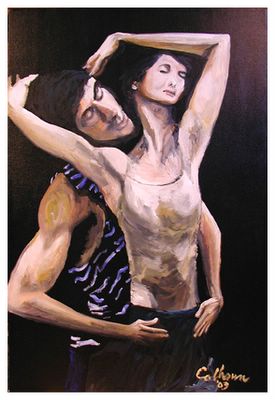Giraffes, and More Turtles
I was out on the front porch with my daughter a few days ago when she decided to teach me a great shoulder tip she learned at ballet class.
She stood behind me and grabbed my upper arms. Then she moved my shoulders forward, then up, then back, then down. That's the way your shoulders should be when you do ballet, she said, "shoulders back, shoulders down and neck long, like a giraffe."

Shoulders down, long neck, like a giraffe
Here's a little experiment we did. You can do it, too.
The take-home lesson you'll want to remember is that you want your neck to be a little bit short like a turtle, not long like a giraffe.

Artist Jim Calhoun shows his interpretation of a ballerina's giraffe neck.
When your arms are dislocated from the shoulder joints and pulling down, as if you were holding two heavy suitcases, the shape of your shoulders and the line of your collar bones slopes down. These are called 'coat-hanger shoulders.'

These are coat-hanger shoulders. See that downward slope? Sorry, you can't see the collar bones.
You know from the test you just did that when you have coat-hanger shoulders you have less freedom and more pain.
When you retract your upper arm bones into your shoulder joints and shrug slightly, so your collar bones are level, you have more freedom to turn your head and less pain.

No coat-hanger shoulders here. Although he's not symetric, his collar bones are level.
So, you tell me, which is better?
When it comes to improved funtion and diminished pain, level collar bones is better!
Here's how Richelle and I adjusted the tip she was given by her ballet instructor to take advantage of what we know about the benefits of level collar bones:
So if I were Richelle's teacher and I were trying to accomplish improved function (not simply an ideal form) I would say this: "Your shoulders should be back, shoulder blades down and neck slightly shortened, like a turtle drawing his head into the shell."
Don't just read about it. Get up. Experience it. Experience yoga!
Kevin Perry
www.ExperienceYoga.org
p.s., By the way, there's a hidden yoga tip in the message I wrote today. Notice that we really want the upper arms back and the shoulder blades down. But Richelles' teacher told her to start by doing the opposite, push the shoulders forward and shrug them up! I give this instruction frequently when the action or movement I want is difficult to accomplish. I think some actions are difficult because I can't feel them very well. You can make the feeling of an action more vivid if you begin by doing the opposite action first. You get a more dramatic experience of the action that you can then build on and refine.
Copyright 2005. All rights reserved, Mo Yoga LLC.
She stood behind me and grabbed my upper arms. Then she moved my shoulders forward, then up, then back, then down. That's the way your shoulders should be when you do ballet, she said, "shoulders back, shoulders down and neck long, like a giraffe."

Shoulders down, long neck, like a giraffe

Here's a little experiment we did. You can do it, too.
Stand up.Here's the test:
Pretend you are holding two heavy suitcases, one in each hand.
Now pull your shoulders down away from your ears, like the ballet dancer Richelle was talking about.
Slowly turn your head all the way from left to right and back again several times, paying attention to how far you can turn your head and to any pain or strain you feel in your neck muscles.Here's the second part of the test:
Instead of pulling your shoulders down, slightly shrug your shoulders up. This is just a slight shrug. Now repeat the head turns.What do you notice about range of motion? When my shoulders are slightly shrugged, my neck muscles are less strained and I can turn my head farther in each direction.
The take-home lesson you'll want to remember is that you want your neck to be a little bit short like a turtle, not long like a giraffe.

Artist Jim Calhoun shows his interpretation of a ballerina's giraffe neck.

When your arms are dislocated from the shoulder joints and pulling down, as if you were holding two heavy suitcases, the shape of your shoulders and the line of your collar bones slopes down. These are called 'coat-hanger shoulders.'

These are coat-hanger shoulders. See that downward slope? Sorry, you can't see the collar bones.

You know from the test you just did that when you have coat-hanger shoulders you have less freedom and more pain.
When you retract your upper arm bones into your shoulder joints and shrug slightly, so your collar bones are level, you have more freedom to turn your head and less pain.

No coat-hanger shoulders here. Although he's not symetric, his collar bones are level.

So, you tell me, which is better?
When it comes to improved funtion and diminished pain, level collar bones is better!
Here's how Richelle and I adjusted the tip she was given by her ballet instructor to take advantage of what we know about the benefits of level collar bones:
Move your shoulders forward.It's a more specific instruction. The shoulder blades move down, while the collar bones stay level. Notice also that when you press the bottom tips of the shoulder blades into the back side of your body, your chest rises.
Shrug your shoulders up slightly,
Then draw your upper arm bones back into the shoulder joints.
Now slide your shoulder blades down your back, as if you were tucking your shoulder blades into your back pants pockets.
So if I were Richelle's teacher and I were trying to accomplish improved function (not simply an ideal form) I would say this: "Your shoulders should be back, shoulder blades down and neck slightly shortened, like a turtle drawing his head into the shell."
Don't just read about it. Get up. Experience it. Experience yoga!
Kevin Perry
www.ExperienceYoga.org
p.s., By the way, there's a hidden yoga tip in the message I wrote today. Notice that we really want the upper arms back and the shoulder blades down. But Richelles' teacher told her to start by doing the opposite, push the shoulders forward and shrug them up! I give this instruction frequently when the action or movement I want is difficult to accomplish. I think some actions are difficult because I can't feel them very well. You can make the feeling of an action more vivid if you begin by doing the opposite action first. You get a more dramatic experience of the action that you can then build on and refine.
Copyright 2005. All rights reserved, Mo Yoga LLC.


0 Comments:
Post a Comment
<< Home